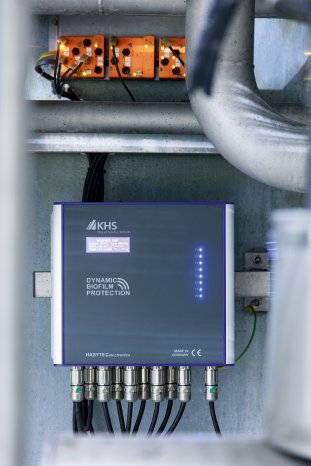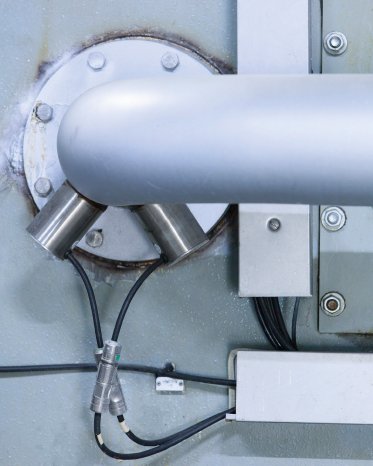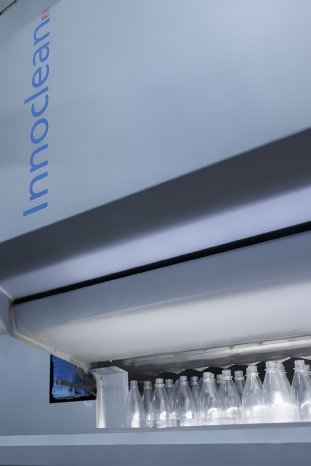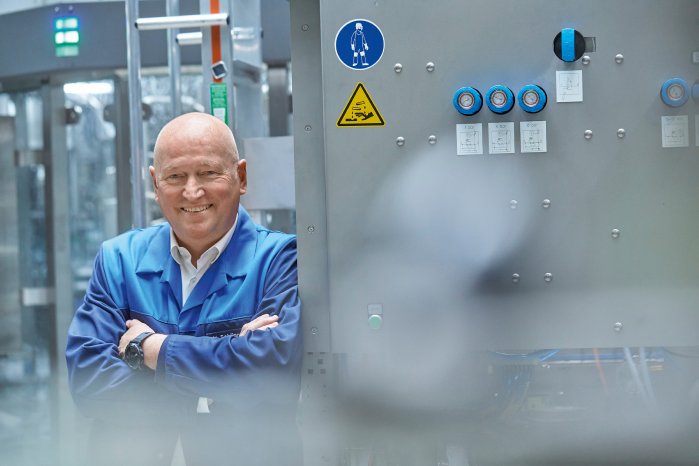“When it comes to sustainability and resource efficiency, we’re one of the pioneers,” explains Robert Mühlenweg, technical and logistics plant manager for the beverage producer. “Our colleagues in the sector thus like to come and see how we’re cutting down on our consumption of water and energy.” As an SME bottler it’s important to move with the times, he believes. And that’s not all: “As we frequently push ourselves to the limit, we tend to be noticed in our branch of industry.” When he and his colleague Jannis Maas, the plant manager responsible for production and supply at BAD MEINBERGER, talk about cutting down on their carbon emissions, they mean genuine climate neutrality – and not mere compensation through the purchase of certificates. Their attitude and resulting success has earned them great trust and plenty of freedom among the managing directors. “In order to further improve our various consumption values, we often try new things out and sometimes even dare to experiment.”
They began exploring one such new avenue with KHS in March 2022 – incidentally not for the first time, for the mineral water company enjoys a long technological partnership with the Dortmund systems supplier. The bottler has repeatedly acted as an extended workbench and pilot customer to the nearby machine and systems manufacturer, enabling new and further developments to be tested under real conditions and fine adjustments made where necessary.
From shipbuilding to the beverage industry
This time the technology isn’t new, however, but a procedure that’s been in use for many years in a completely different sector, namely shipbuilding, and is now being applied to the beverage industry. KHS HASYTEC Dynamic Biofilm Protection is a simple plug-and-produce product where ultrasonic transducers cause the liquid in certain components of the machine to gently vibrate. The system is currently available for both bottle washing machines and pasteurizers – whether for new machines or as a conversion for existing systems.
At BAD MEINBERGER Dynamic Biofilm Protection reduces deposits of biofilm, limestone and fibrous material from paper labels in the spray pipes on the KHS Innoclean EE bottle washer, for example. In the past, without this system machinery often became clogged with deposits that required a considerable amount of effort to remove. “The combination of paper and limestone in particular presented us with a real challenge,” says Maas. “Our colleagues often had to get to work with a chisel!”
Ultrasound not muscle power
It’s not just the time-consuming physical labor that’s hard work when it comes to cleaning machine parts. In the peak season especially, with the plant running at full capacity, finding an appropriate slot for cleaning often proves something of a headache. “Before we installed the ultrasonic converter, the level of calcification on the machine had to be checked at the latest every two months and the machine then descaled and partly dismantled in order to remove the deposits formed. This took up an entire day that had to be blocked off in the production schedule or moved to a weekend. And even if the team is basically motivated to put in a shift on a Saturday or Sunday during the peak season if this is necessary, they’re understandably not desperate to do this work that’s strenuous and unproductive,” Maas emphasizes.
The Dynamic Biofilm Protection system, complete with two control units and twelve ultrasonic transducers, has been in operation at BAD MEINBERGER for about 18 months now. “It was primarily our trust in KHS that prompted us to install the system,” Mühlenweg remembers. “And of course we were also convinced by the fact that the process has been in use for many years without any problems, even in huge shipping containers.” The reason for this is easy to comprehend: the liquid is oscillated, thus keeping the particulate matter contained in it in motion, not by a constant permanent frequency but by intermittent pulses.
Autonomous and maintenance free
In the end, the engineers’ curiosity won them over, resulted in the mineral water bottling plant being one of the first beverage operations to use this technology. “This was one of the best decisions we’ve ever made,” says Mühlenweg happily. “We often filled an entire wheelbarrow with deposits in the past; now we barely need a 20-liter bucket. And this year we haven’t yet had to carry out a single acid treatment. The system is completely autonomous and practically maintenance free.” Maas smiles that “the new system is making itself noticeable here by being unnoticeable. Or, to put it another way, the best service is the service you don’t need.”
BAD MEINBERGER is also being supported in its striving for greater sustainability by the use of the new procedure. “On the one hand, the Dynamic Biofilm Protection system considerably lengthens the time between cleaning operations and reduces downtime, thus enabling a significant increase in production,” stresses Kathrin Gareis, service product manager at KHS. “On the other, the consumption of water, heat, electricity and chemicals such as citric acid used to descale components is greatly decreased by this system. Besides the cuts in operating costs this results in, this also helps to save energy and resources – an issue which is so important to our customers.”
Potential resource savings
In this context, Mühlenweg and Maas monitor the quality of the caustic in their bottle washer extremely carefully. They use about 40 cubic meters of it which – should it have to be discarded – first needs to be brought up to the right temperature and then dosed with new chemicals each time. There’s thus constant filtration during filling and only the exact same amount of fresh water or caustic is added as is lost through the removed labels, for instance. At the same time, owing to specific process parameters that have a high risk of forming deposits, the caustic temperature at BAD MEINBERGER has been lowered through close cooperation with the laboratory. “Most beverage producers use higher temperatures but that’s not our intention,” Mühlenweg states. “In view of the high costs for heat generation, at the moment our sector is undergoing a rethink. Lots of colleagues could follow our lead here.”
Gareis totally agrees and not only sees deposits being greatly reduced and intervals between cleaning cycles becoming longer for both current and future KHS customers thanks to Dynamic Biofilm Protection but also potential for saving on energy and resources.
DYNAMIC BIOFILM PROTECTION AT A GLANCE
Ultrasonic transducers to reduce deposit formation on heat exchangers, process water baths, pipes and sprays; option for new machines or as a retrofit for existing KHS systems.
- Longer cleaning intervals
- Less downtime
- Increased production
- Fewer personnel hours needed for cleaning
- Water, electricity, heat and chemical savings
- Lower operating costs







